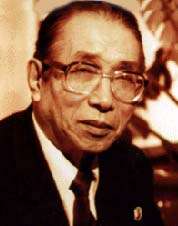Kim Won-gyun
| Kim Won-gyun | |
|---|---|
 | |
| Born |
2 January 1917 Wonsan, Kangwon Province, Korea[1] |
| Died | 5 April 2002 (aged 85) |
| Occupation | Composer, politician |
| Era | 20th century |
| Kim Won-gyun | |
| Chosŏn'gŭl | 김원균 |
|---|---|
| Hancha | 金元均 |
| Revised Romanization | Kim Won-gyun |
| McCune–Reischauer | Kim Wŏn'gyun |
| [1][2][3] | |
Kim Won-gyun (Chosŏn'gŭl: 김원균; 2 January 1917 – 5 April 2002)[4] was a North Korean composer and politician. He is considered one of the most prominent,[5] if not the most celebrated,[6] composer of North Korea. He composed "Aegukka" — the national anthem of the country — and "Song of General Kim Il-sung", in addition to revolutionary operas.[5]
Career
In his youth, he attended high school but dropped out after three grades.[4] Before his musical career, Kim was only "a farmer who just happened to write [the] 'Song of General Kim Il Sung'".[6] That was in 1946, very early into the cult of personality of Kim Il-sung; the song was the first work of art that ostensibly mentions Kim Il-sung.[7] After the success of the song, he was asked to compose "Aegukka". As a musician, he was initially self-taught but went to Moscow in order to study there.[8] At some point he attended a music school in Japan.[5] By 1947, when "Aegukka" was adapted as the national anthem,[9] he had risen in status.[6] Other compositions by Kim include: "March of Korea", "Democratic Youth March", "Our Supreme Commander", "Glory to the Workers' Party of Korea", "Sunrise on Mt. Paektu", "Steel-stong Ranks Advance", "Song of Great National Unity",[10] "We Rush Forward in Spirit of Chollima", and "Song of Anti-Imperialist Struggle".[11]
Kim is credited with contributing to "the creation of the 'Sea of Blood' -type revolutionary operas".[10] It is possible that he worked on the operatic version of Sea of Blood and a symphony based on music from the opera.[12] He is also credited with the opera Chirisan.[13]
Kim became the head of the Central Committee of the Korean Musicians Union in 1954, and would later become the vice-president and president of the Union.[5] He was the president of the Pyongyang University of Music and Dance since 1960. In 1985, he became the general director of the Sea of Blood Opera Troupe.[5][10] He was the North Korean chairman of the Reunification Music Festival in September 1990.[5] He was also the chairman of the National Music Committee of Korea[14] and honorary member of the International Music Council.[15] Besides his musical activities, he was a deputy to the ninth and tenth Supreme People's Assemblies (SPA).[5] Upon his death in 2002, he held the posts of deputy to the SPA and adviser to the Central Committee of the Korean Musicians Union.[16]
He received many prizes and honours, including Labour Hero, Merited Artist, People's Artist, recipient of the Order of Kim Il-sung and a Kim Il-sung Prize winner.[5][15] The Pyongyang Conservatory was renamed the Kim Won-gyun Conservatory on 27 June 2006.[5][10]
Kim Won-gyun died on 5 April 2002 of heart failure. Kim Jong-il sent a wreath to his bier on the day following his death.[16]
See also
References
- 1 2 Yonhap News Agency, Seoul (27 December 2002). North Korea Handbook. M.E. Sharpe. p. 39. ISBN 978-0-7656-3523-5. Retrieved 5 July 2015.
- ↑ "Gukka" 국가(國歌). JoongAng Ilbo (in Korean). Retrieved 5 July 2015.
- ↑ George Ginsburgs (1974). Soviet Works on Korea, 1945-1970: Prepared for the Joint Committee on Korean Studies of the American Council of Learned Societies and the Social Science Research Council. University of Southern California Press. p. 137. Retrieved 5 July 2015.
- 1 2 내나라 [Kim Won-gyun]. Naenara (in Korean). Archived from the original on 13 August 2009. Retrieved 5 July 2015.
- 1 2 3 4 5 6 7 8 9 James E. Hoare (13 July 2012). Historical Dictionary of Democratic People's Republic of Korea. Scarecrow Press. p. 224. ISBN 978-0-8108-7987-4. Retrieved 5 July 2015.
- 1 2 3 Marie Korpe (4 September 2004). Shoot the Singer!: Music Censorship Today. Zed Books. p. 220. ISBN 978-1-84277-505-9. Retrieved 5 July 2015.
- ↑ Jae-Cheon Lim (24 March 2015). Leader Symbols and Personality Cult in North Korea: The Leader State. Routledge. p. 29. ISBN 978-1-317-56741-7. Retrieved 5 July 2015.
- ↑ Portal, Jane (15 August 2005). Art Under Control in North Korea. Reaktion Books. pp. 92–93. ISBN 978-1-86189-236-2. Retrieved 5 July 2015.
- ↑ IBP, Inc. (13 April 2015). Korea North Country Study Guide Volume 1 Strategic Information and Developments. Lulu.com. p. 18. ISBN 978-1-4330-2780-2. Retrieved 5 July 2015.
- 1 2 3 4 "Famous Musician Kim Won Gyun". KCNA. 30 June 2006. Retrieved 5 July 2015.
- ↑ "Kim Won Gyun concert". KCNA. 10 March 1997. Retrieved 5 July 2015.
- ↑ Keith Howard (22 December 2004). "Dancing for the Eternal President". In Annie J. Randall. Music, Power, and Politics. Routledge. pp. 130, 178. ISBN 1-135-94690-6. Retrieved 5 July 2015.
- ↑ "Korea". The Great Soviet Encyclopedia (3rd ed.). The Gale Group. 1970–1979. Retrieved 5 July 2015 – via TheFreeDictionary.com.
- ↑ Yonhap News Agency (2000). Korea Annual. Yonhap News Agency. p. 284. Retrieved 5 July 2015.
- 1 2 "Composer Living along with Conservatory". KCNA. 10 August 2009. Archived from the original on 12 October 2014. Retrieved 5 July 2015.
- 1 2 "Kim Won Gyun passed away". KCNA. 6 April 2002. Retrieved 5 July 2015.
Further reading
- Kim Sunnam; Kim Won-gyun (1953). "Iskusstvo sluzhit narodu (O razvitii muzykainoi kultury Koreisko Narodno-Demokraticheskoi Respubliki)" [Art Serves the People: On the Musical Culture of the Korean People's Democratic Republic]. Sovetskaya muzyka (in Russian) (3): 109–111.
External links
- Bust in front of the Kim Won-gyun Conservatory at WikiMapia
- Article at Baike.com (in Chinese)
- Documentary on Channel A's channel on YouTube (in Korean)
- Documentary on Uriminzokkiri's channel on YouTube (in Korean)